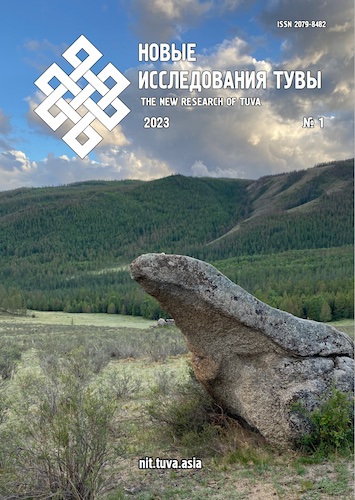Neurosemantic characteristics of common words in the Tuvan language through the prism of a complex psycholinguistic experiment
DOI:
https://doi.org/10.25178/nit.2023.1.10Keywords:
psycholinguistic experiment; neurosemantics; psycholinguistic properties of words; usual vocabulary; Tuvan language; Tuvan-Russian bilingualismAbstract
The purpose of the study is to describe the neurosemantic characteristics of 73 nouns used in the oral speech of the Tuvans: 55 are words of the Tuvan language, 18 are from Russian. We obtained the word list in a psycholinguistic experiment with 150 Tuvan-Russian bilinguals whose average age was 22.6 years. Five groups of noun stimuli were identified: culturally significant words (names of rituals and their elements, natural objects with a high symbolic load in the traditional worldview, kinship terms); zoonyms; names of household objects in Tuvan, names of household objects in Russian, and vocabulary of the everyday.
The research problem lies in the field of joint inquiries of cognitive linguistics, neurosemantics and aphasiology. It is a case of searching for a neural correlate that is called the meaning of a word in traditional linguistics. According to F. Pulvermüller’s neurosemantic conception, such a correlate is a distributed structure of neurons. In being activated, they allow a person to get a “feeling” of a word and provide understanding.
In order to conduct the experiment, we used a methodology already well-tested in perceptual semantics to identify such psycholinguistic properties of words as subjective frequency, age of acquisition, imageability, familiarity with a concept. The novelty of the work is that for the first time using the Tuvan language material we have found out which groups of words different psycholinguistic properties are essential for and which neurosemantic characteristics of words they correlate with (sensorimotor experience, visual perception, experience of engagement with a word).
We hypothesize about factors affecting the identified characteristics of words and specify words that have neural correlates with the strongest connections. It has been found out that in case of culturally significant words the property “familiarity with a concept” turns out to be relatively high in value and the strongest in influence on other properties; in case of zoonyms it is “imageability”; in case of everyday vocabulary it is “subjective frequency” which strongly correlates with the “age of acquisition”. It is “familiarity with a concept” in case of names of household items in Tuvan. The subjective frequency has the greatest influence on other properties in Russian.
The reflection of the informants has shown that the household sphere is most affected by the competition between words of the native and non-native languages. Those Tuvan words which are most deeply influenced by this competition have the lowest values of psycholinguistic properties.
References
Akinina, Yu. S., Iskra, E. V., Ivanova, M. V., Grabovskaya, M. V., Isaev, Yu. D., Korkina, I. D., Malyutina, S. A. and Sergeeva, N. Yu. (2014) Biblioteka stimulov «Sushchestvitel'noe i ob"ekt»: normirovanie psikholingvisticheskikh parametrov [Collection of stimuli “Noun and object”: normalization of psycholinguistic properties of words]. In: Shestaia mezhdunarodnaia konferentsiia po kognitivnoi nauke [The Sixth International Conference on Cognitive Science] : Abstracts. Kaliningrad, June 23–27, 2014 / ed. by A. A. Kibrik et al. Kaliningrad, s. n. 752 p. Pp. 112‒114. (In Russ.).
Akhutina, T. V. (2014) Neirolingvisticheskii analiz leksiki, semantiki i pragmatiki [Neurolinguistic analysis of vocabulary, semantics and pragmatics]. Moscow, Iazyki slavianskoi kul'tury. 423 p. (In Russ.).
Bitkeeva, A. N. (2022) Model’ sotsiolingvisticheskogo prognozirovaniia i aktual’nye tendentsii iazykovoi politiki v regionakh Rossii [Model of sociolinguistic forecasting and the current trends of language policy in the regions of Russia]. New Research of Tuva, no. 4, pp. 38–52. (In Russ.). DOI: https://doi.org/10.25178/nit.2022.4.3
Kolmogorova, A. V. (2021) Psikholingvisticheskie parametry russkikh slov i ikh vizual'nykh korreliatov v iazykovom soznanii tuvinsko-russkikh bilingvov: opyt eksperimental'nogo issledovaniia [Psycholinguistic properties of the Russian words and their visual correlates in the linguistic conscience of Tuvan-Russian bilinguals: An experiment-based study]. New Research of Tuva, no. 2, pp. 197–210 (In Russ.). DOI: https://doi.org/10.25178/nit.2021.2.16
Nekrasova, E. A. (2016) Vzaimozavisimost' modal'noi semantiki slova i pertseptivnogo kanala pred"iavleniia informatsii [The semantics of words and a perceptive channel: The impact of sensomotor experience on the perception of words]. Tomsk State University Journal, № 402, pp. 10–17. (In Russ.). DOI: https://doi.org/10.17223/15617793/402/2
Tsybenova, Ch. S. (2013) Assotsiativnyi eksperiment v kontekste issledovaniia iazykovoi situatsii: na primere Respubliki Tyva [Associative experiment in the study of a language situation: The case of the Republic of Tyva]. Voprosy psikholingvistiki, issue 17, pp. 180–193. (In Russ.).
Akinina, Y., Malyutina, S., Ivanova, M., Iskra, E., Mannova, E. and Dragoy, O. (2015) Russian normative data for 375 action pictures and verbs. Behavior Research Methods, vol. 47, no. 3, pp. 691–707. DOI: https://doi.org/10.3758/s13428-014-0492-9
Balota, D. A., Pilotti, M. and Cortese, M. J. (2001) Subjective frequency estimates for 2,938 monosyllabic words. Memory and Cognition, vol. 29, pp. 639–647. DOI: https://doi.org/10.3758/BF03200465
Chedid, G., Sfeir, M., Mouzawak, M, Saroufim, L., Hayek, P., Wilson, M. A. and Brambati, S. M. (2022) A standardized set of 380 pictures for Lebanese Arabic: Norms for name agreement, conceptual familiarity, imageability, and subjective frequency. Journal of Psycholinguist Research, vol. 51, no. 1, pp. 93−133. (In Russ.). DOI: https://doi.org/10.1007/s10936-021-09826-8
Collins, A. M. and Loftus, E. F. (1975) A spreading activation theory of semantic processing. Psychological Review, vol. 82, no. 6, pp. 407−428.
Connell, L. and Lynott, D. (2012) Strength of perceptual experience predicts word processing performance better than concreteness or imageability. Cognition, vol. 125, no. 3, pp. 452–465. https://doi.org/10.1016/j.cognition.2012.07.010
Damasio, H., Grabowski, T. J., Tranel, D., Hichwa, R. D. and Damasio, A. R. (1996) A neural basis for lexical retrieval. Nature, vol. 380, pp. 499–505. DOI: https://doi.org/10.1038/380499a0
Gernsbacher, M. A. (1984) Resolving 20 years of inconsistent interactions between lexical familiarity and orthography, concreteness, and polysemy. Journal of Experimental Psychology, vol. 113, no. 2, pp. 256−281. DOI: https://doi.org/10.1037//0096-3445.113.2.256
Gilhooly, K. J., and Logie, R. H. (1980) Age-of-acquisition, imagery, concreteness, familiarity, and ambiguity measures for 1,944 words. Behavior Research Methods & Instrumentation, vol. 12, pp. 395−427. DOI: https://doi.org/10.3758/BF03201693
Kiefer, M. and Pulvermüller, F. (2012) Conceptual representations in mind and brain: Theoretical developments, current evidence and future directions. Cortex, vol. 48, issue 7, pp. 805–825. DOI: https://doi.org/10.1016/j.cortex.2011.04.006
Miklashevsky, A. (2018) Perceptual experience norms for 506 Russian nouns: Modality rating, spatial localization, manipulability, imageability and other variables. Journal of Psycholinguistic Research, vol. 47, no. 3, pp. 641−661. DOI: https://doi.org/10.1007/s10936-017-9548-1
Paetzold, G. and Specia, L. (2016) Inferring psycholinguistic properties of words. In: Proceedings of the 2016 Conference of the North American Chapter of the Association for Computational Linguistics: Human Language Technologies. San Diego, California. Association for Computational Linguistics. Pp. 435−440. DOI: https://doi.org/10.18653/v1/N16-1050
Patterson, K., Nestor, P. J. and Rogers, T. T. (2007) Where do you know what you know? The representation of semantic knowledge in the human brain. Nature Reviews Neuroscience, vol. 8, pp. 976–987. DOI: https://doi.org/10.1038/nrn2277
Pulvermüller, F. (1999) Words in the brain’s language. Behavioral and Brain Sciences, vol. 22, no. 2, pp. 253–279. DOI: http://dx.doi.org/10.1017/S0140525X9900182X
Pulvermüller, F. (2002) Brain reflections of words and their meaning. Trends in Cognitive Sciences, vol. 5, no. 12, pp. 517−524. DOI: https://doi.org/10.1016/S1364-6613(00)01803-9
Pulvermüller, F. (2013) How neurons make meaning: brain mechanisms for embodied and abstract-symbolic semantics. Trends in Cognitive Sciences, vol. 17, no. 9, pp. 458−470. DOI: https://doi.org/10.1016/j.tics.2013.06.004
Speed, L. J. and Brybaert, M. (2022) Dutch sensory modality norms. Behavior Research, vol. 54, pp. 1306–1318. DOI: https://doi.org/10.3758/s13428-021-01656-9
Waxman, S. R. and Booth, A. E. (2000) Principles that are invoked in the acquisition of words, but not facts. Cognition, vol. 77, no. 2, pp. 33– 43. DOI: https://doi.org/10.1016/S0010-0277(00)00103-7
Zevin, J. (2009) Word Recognition. Encyclopedia of Neuroscience, pp. 517–522. DOI: https://doi.org/10.1016/b978-008045046-9.01881-7
Published
How to Cite
For citation:
Kolmogorova A. V. and Natpit A. A. Neirosemanticheskie kharakteristiki upotrebitel’nykh slov tuvinskogo iazyka cherez prizmu kompleksnogo psikholingvisticheskogo eksperimenta [Neurosemantic characteristics of common words in the Tuvan language through the prism of a complex psycholinguistic experiment]. New Research of Tuva, 2023, no. 1, pp. 170‑185. (In Russ.). DOI: https://doi.org/10.25178/nit.2023.1.10
Issue
Section

This work is licensed under a Creative Commons Attribution-NonCommercial 4.0 International License.

Author(s) license holder(s) grant rights for their work to the journal (grantee of a license) under the simple non-exclusive open license in accordance with Art. 1286.1 «Open license for a research work, work of literature or fine arts», Civil Code of the Russian Federation.
New Research of Tuva publishes articles under the Creative Commons Attribution-NonCommercial license (CC BY-NC).
Since it is an open license, author(s) reserve the right to upload the article to their institutional repository, submit it to another journal (if it allows republications), or republish it on their own website (in full, or in part).
However, several conditions apply here:
a) The republished version must always contain the name(s) and affiliation(s) of the author(s), the original title and the hyperlink to the original version on the New Research of Tuva website;
b) It must be in open access, free of charge, and no category of readers must be in any way whatsoever advantaged over general readership.
c) should the contribution be submitted elsewhere by its author(s) without substantial modification (30% or more of original text unchanged), the body of the article should contain a disclaimer that the original version was published in New Research of Tuva (with a link to the respective page)
The CC-BY-NC is a non-revocable license which applies worldwide and lasts for the duration of the work’s copyright.










